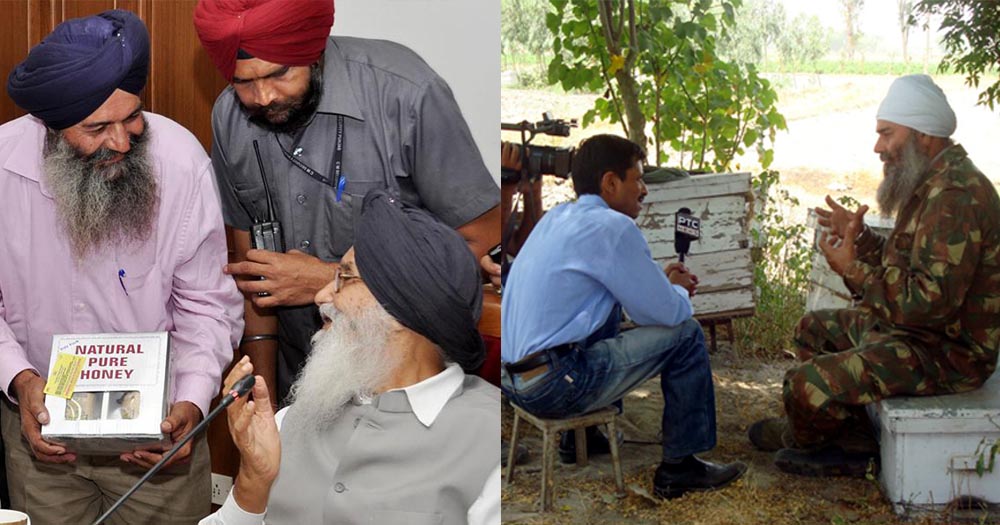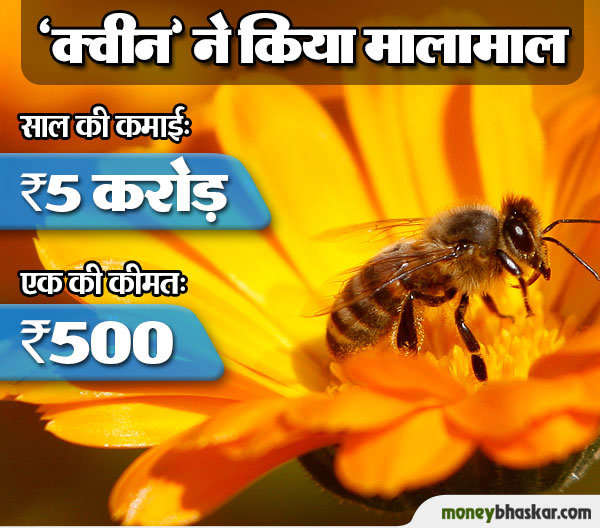
ਇੱਕ ਬੰਦੇ ਨੇ 500-500 ਰੁਪਏ ਵਿੱਚ ਇੱਕ-ਇੱਕ ‘ਰਾਣੀ’ ਵੇਚ ਕੇ ਲੱਖਾਂ ਰੁਪਏ ਦਾ ਕੰਮ-ਕਾਜ ਖੜ੍ਹਾ ਕਰ ਲਿਆ। ਇਹ ਮਜ਼ਾਕ ਨਹੀਂ ਹਕੀਕਤ ਹੈ। ਜਿਸ ਰਾਣੀ ਦੀ ਵਿੱਕਰੀ 500 ਰੁਪਏ ਵਿੱਚ ਹੋ ਰਹੀ ਹੈ, ਉਹ ਮਧੂ ਮੱਖੀਆਂ ਦੀ ਰਾਣੀ ‘ਕਵੀਨ ਬੀ’ ਹੈ। ਇਨ੍ਹਾਂ ਦਾ ਬਿਜ਼ਨੈਸ ਕਰਨ ਵਾਲਾ ਵਿਅਕਤੀ ਪੰਜਾਬ ਦੇ ਕਪੂਰਥਲਾ ਜ਼ਿਲ੍ਹੇ ਦੀ ਤਹਿਸੀਲ ਸੁਲਤਾਨਪੁਰ ਲੋਧੀ ਦੇ ਪਿੰਡ ਬੂਲਪੁਰ ਦਾ ਵਾਸੀ ਸਰਵਣ ਸਿੰਘ ਚੰਦੀ ਹੈ।
ਮਧੂ ਮੱਖੀਆਂ ਦੀ ਰਾਣੀ ਤਿਆਰ ਕਰਨ ਲਈ ਵਿਸ਼ੇਸ਼ ਕਿੱਟ ਦੀ ਜ਼ਰੂਰਤ ਹੁੰਦੀ ਹੈ, ਜੋ ਬ੍ਰਿਟੇਨ ਜਾਂ ਅਮਰੀਕਾ ਤੋਂ ਇੰਪੋਰਟ ਕੀਤੀ ਜਾਂਦੀ ਹੈ। ਰਾਣੀ ਮੱਖੀ ਤਿਆਰ ਕਰਨ ਲਈ 45 ਦਿਨ ਦਾ ਸਮਾਂ ਲੱਗਦਾ ਹੈ। ਸਾਰੀ ਪ੍ਰਕਿਰਿਆ 69 ਡਿਗਰੀ ਸੈਲਸੀਅਸ ਤਾਪਮਾਨ ਉੱਤੇ ਹੁੰਦੀ ਹੈ। ਇਸ ਨੂੰ ਸ਼ਹਿਦ ਉਤਪਾਦਨ ਕਰਨ ਵਾਲਿਆਂ ਨੂੰ ਵੇਚ ਦਿੱਤਾ ਜਾਂਦਾ ਹੈ।
ਕਵੀਨ-ਬੀ ਪਾਲਕ ਸਰਵਣ ਸਿੰਘ ਚੰਦੀ ਅਨੁਸਾਰ ਇੱਕ ਬਾਕਸ ਤੋਂ ਸ਼ਹਿਦ ਉਤਪਾਦਨ ਨਾਲ ਇੱਕ ਸਾਲ ਵਿੱਚ 2 ਤੋਂ 3 ਹਜ਼ਾਰ ਰੁਪਏ ਕਮਾਏ ਜਾ ਸਕਦੇ ਹਨ ਪਰ ਰਾਣੀ ਮੱਖੀ ਨਾਲ ਲੱਖਾਂ ਰੁਪਏ। ਇੱਕ ਬਰੀਡ ਬਾਕਸ ਵਿੱਚ 45 ਦਿਨਾਂ ਵਿੱਚ 300 ਰਾਣੀ ਮਧੂ ਮੱਖੀਆਂ ਬਣਾਈਆਂ ਜਾ ਸਕਦੀਆਂ ਹਨ। ਇੱਕ ਰਾਣੀ ਮਧੂ ਮੱਖੀ ਦੀ ਕੀਮਤ 500 ਰੁਪਏ ਤੋਂ ਵੀ ਜ਼ਿਆਦਾ ਹੁੰਦੀ ਹੈ। ਕੇਵਲ 45 ਦਿਨਾਂ ਬਾਅਦ ਹੀ ਇੱਕ ਬਰੀਡ ਬਾਕਸ ਤੋਂ 1.5 ਲੱਖ ਰੁਪਏ ਤੱਕ ਕਮਾਏ ਜਾ ਸਕਦੇ ਹਨ। ਜਦੋਂਕਿ ਸ਼ਹਿਦ ਉਤਪਾਦਨ ਵਿੱਚ ਜ਼ਿਆਦਾ ਵਕਤ ਲੱਗਦਾ ਹੈ। ਸ਼ਹਿਦ ਦੀ ਜ਼ਿਆਦਾ ਕੀਮਤ ਦੇ ਚੱਲਦੇ ਇੱਕ ਮੱਖੀ ਦੀ ਕੀਮਤ 800 ਰੁਪਏ ਤੱਕ ਹੋ ਜਾਂਦੀ ਹੈ।
ਕਿਸਾਨ ਚੰਦੀ ਨੇ ਖੇਤੀ ਦੇ ਸਹਾਇਕ ਧੰਦਿਆਂ ਵਿੱਚੋਂ ਮਧੂ ਮੱਖੀ ਪਾਲਨ ਨੂੰ ਰੀਝ ਨਾਲ ਅਪਣਾਇਆ ਹੈ। ਉਨ੍ਹਾਂ ਨੇ ਮਾਰਚ 1995 ਵਿੱਚ ਸ਼ਹਿਦ ਦੀਆਂ ਮੱਖੀਆਂ ਪਾਲਨ ਦੀ ਟ੍ਰੇਨਿੰਗ ਲੈ ਕੇ 50 ਬਕਸੇ ਮੱਖੀਆਂ ਦੇ ਖ਼ਰੀਦ ਕੇ ਕੰਮ ਕਰਨਾ ਸ਼ੁਰੂ ਕਰ ਦਿੱਤਾ। ਪਹਿਲੇ ਹੀ ਸਾਲ ਉਨ੍ਹਾਂ ਨੇ 350 ਕਿੱਲੋ ਸ਼ਹਿਦ ਪ੍ਰਾਪਤ ਕਰਕੇ ਇਸ ਕੰਮ ਨੂੰ ਹੋਰ ਲੱਗਣ ਨਾਲ ਕਰਨਾ ਸ਼ੁਰੂ ਕਰ ਦਿੱਤਾ।
ਸਾਲ 1996 ਵਿੱਚ ਉਨ੍ਹਾਂ ਨੇ ਸ਼ਹਿਦ ਦੀ ਮਾਰਕੀਟਿੰਗ ਕਰਨ ਲਈ ਆਪਣਾ ਸ਼ਹਿਦ ਪੰਜਾਬ ਸਰਕਾਰ ਤੇ ਭਾਰਤ ਸਰਕਾਰ ਦੇ ਮਾਰਕੀਟਿੰਗ ਮਹਿਕਮੇ ਤੋਂ ਐਗਮਾਰਕ ਕਰਵਾ ਲਿਆ। ਜ਼ਲਾਇਨ ਬਰਾਂਡ ਹਨੀਜ਼ ਦੇ ਨਾਂ ਹੇਠ ਪੈਕ ਕਰਕੇ ਪੰਜਾਬ ਖੇਤੀਬਾੜੀ ਯੂਨੀਵਰਸਿਟੀ, ਲੁਧਿਆਣਾ ਤੋਂ ਆਧੁਨਿਕ ਪੈਕਿੰਗ ਕਰਨ ਦੀ ਟ੍ਰੇਨਿੰਗ ਲੈ ਕੇ ਆਪਣੇ ਸ਼ਹਿਦ ਨੂੰ ਵੇਚਣਾ ਸ਼ੁਰੂ ਕਰ ਦਿੱਤਾ।
ਉਨ੍ਹਾਂ ਨੇ 2011 ਵਿੱਚ ਸ਼ਹਿਦ ਪ੍ਰੋਸੈਸਿੰਗ ਇਕਾਈ ਦੀ ਸਥਾਪਨਾ ਕੀਤੀ ਤੇ ਉੱਚ ਮਿਆਰ ਦੀ ਪੈਕਿੰਗ ਕਰਕੇ ਆਪਣਾ ਸ਼ਹਿਦ ਵੇਚ ਰਹੇ ਹਨ। ਉਹ ਕਿਸਾਨ ਮੇਲਿਆਂ, ਸਭਿਆਚਾਰਕ ਮੇਲਿਆਂ ਤੇ ਹੋਰ ਥਾਵਾਂ ‘ਤੇ ਆਪਣੇ ਖੇਤੀ ਉਤਪਾਦਾਂ ਦਾ ਸਟਾਲ ਲਾ ਕੇ ਸ਼ਹਿਦ ਵੇਚਦੇ ਹਨ। ਉਹ ਸ਼ਹਿਦ ਦਾ ਮੰਡੀਕਰਨ ਪ੍ਰੋਗਰੈਸਿਵ ਬੀ-ਕੀਪਰਜ਼ ਐਸੋਸੀਏਸ਼ਨ (ਰਜਿ.) ਰਾਹੀਂ ਦੂਸਰੇ ਰਾਜਾਂ ਤੇ ਬਾਹਰਲੇ ਦੇਸ਼ਾਂ ਨੂੰ ਵੀ ਕਰਦੇ ਹਨ। ਮੌਜੂਦਾ ਸਮੇਂ ਵਿੱਚ ਉਨ੍ਹਾਂ ਪਾਸ 650 ਮੱਖੀਆਂ ਦੇ ਬਕਸੇ ਹਨ। ਸਾਲ 2002 ਵਿੱਚ ਸੰਗਰੂਰ ਵਿੱਚ ਹੋਏ ਰਾਜ ਪੱਧਰੀ ਸਮਾਗਮ ਵਿੱਚ ਉਸ ਸਮੇਂ ਦੇ ਖੇਤੀ ਮੰਤਰੀ ਚੌਧਰੀ ਅਜੀਤ ਸਿੰਘ ਨੇ ਸਹਿਕਾਰਤਾ ਵਿਭਾਗ ਵੱਲੋਂ ਉੱਦਮੀ ਕਿਸਾਨ ਐਵਾਰਡ ਨਾਲ ਸਨਮਾਨਤ ਕੀਤਾ।
ਮੱਖੀ ਪਾਲਨ ਤੋਂ ਇਲਾਵਾ ਉਨ੍ਹਾਂ ਕੋਲ ਆਪਣੀ ਵਿਰਾਸਤੀ ਜ਼ਮੀਨ ਕੇਵਲ 14 ਏਕੜ ਹੈ ਪਰ 16 ਏਕੜ ਜ਼ਮੀਨ ਠੇਕੇ ’ਤੇ ਲੈ ਕੇ ਉਹ ਇਸ ਵੇਲੇ ਕੁੱਲ 30 ਏਕੜ ਦੀ ਖੇਤੀ ਕਰ ਰਹੇ ਹਨ। ਪੀ.ਏ.ਯੂ ਦੇ ਸਾਇੰਸਦਾਨਾਂ ਵੱਲੋਂ ਪਾਣੀ ਬਚਾਉਣ ਤੇ ਖੇਤੀ ਖ਼ਰਚੇ ਘਟਾਉਣ ਦੀਆਂ ਸਿਫ਼ਾਰਸ਼ਾਂ ਅਨੁਸਾਰ ਉਹ ਹਾੜ੍ਹੀ ਦੀਆਂ ਫ਼ਸਲਾਂ ਜਿਵੇਂ ਕਣਕ, ਆਲੂ, ਦਾਲਾਂ (ਕਾਲੇ ਛੋਲੇ), ਸ਼ਿਮਲਾ ਮਿਰਚ, ਸੂਰਜਮੁਖੀ ਤੇ ਬਰਸੀਮ (ਹਰਾ ਚਾਰਾ) ਦੀ ਖੇਤੀ ਕਰ ਰਹੇ ਹਨ।
ਉਨ੍ਹਾਂ ਨੂੰ ਫ਼ਸਲੀ ਵਿਭਿੰਨਤਾ ਵਾਲੇ ਮਾਡਲ ਤੋਂ ਹਾੜੀ ਰੁੱਤ ਦੌਰਾਨ ਕੁੱਲ ਆਮਦਨ 10,37,600 ਰੁਪਏ ਹੋਈ। ਜੇਕਰ ਉਹ ਪੂਰੇ ਰਕਬੇ (30 ਏਕੜ) ਵਿੱਚ ਕਣਕ ਦੀ ਹੀ ਫ਼ਸਲ ਲੈਂਦੇ ਤਾਂ ਉਨ੍ਹਾਂ ਨੂੰ 8,98,909 ਰੁਪਏ ਦੀ ਵੱਟਤ ਹੋਣੀ ਸੀ। ਇਸ ਤਰ੍ਹਾਂ ਕਣਕ ਦੀ ਫ਼ਸਲ ਦੇ ਮੁਕਾਬਲੇ, ਵੱਖ-ਵੱਖ ਫ਼ਸਲਾਂ ਬੀਜਣ ਨਾਲ ਉਨ੍ਹਾਂ ਨੂੰ 1,38,691 ਰੁਪਏ ਵੱਧ ਆਮਦਨ ਹੋਈ।
ਸਾਉਣੀ ਰੁੱਤ ਵਿੱਚ ਉਹ ਝੋਨਾ, ਬਾਸਮਤੀ, ਚਾਰੇ ਵਾਲੀ ਮੱਕੀ, ਦਾਲਾਂ (ਸੱਠੀ ਮੂੰਗੀ), ਸਾਉਣੀ ਰੁੱਤ ਦੇ ਪਿਆਜ਼ ਦੀ ਖੇਤੀ ਕਰ ਰਹੇ ਹਨ ਜਿਸ ਤੋਂ ਉਨ੍ਹਾਂ ਨੂੰ ਵੱਟਤ ਹੋ ਰਹੀ ਹੈ। ਉਨ੍ਹਾਂ ਨੂੰ ਸਾਉਣੀ ਰੁੱਤ ਦੌਰਾਨ ਵੱਖ-ਵੱਖ ਫ਼ਸਲਾਂ ਬੀਜਣ ਨਾਲ 9,50,250 ਰੁਪਏ ਦੀ ਕੁੱਲ ਆਮਦਨ ਹੋਈ। ਦੋਵੇਂ ਰੁੱਤਾਂ ਦੌਰਾਨ ਉਨ੍ਹਾਂ ਨੂੰ ਕੁੱਲ ਮਿਲਾ ਕੇ 19,87, 850 ਰੁਪਏ ਦੀ ਆਮਦਨ ਹੋਈ। ਆਪਣੇ ਖੇਤਾਂ ਦੀ ਮੋਟਰ ਤੇ ਪਰਿਵਾਰਕ ਮੈਂਬਰਾਂ ਵਾਸਤੇ ਅਮਰੂਦ, ਪਪੀਤਾ, ਕਿੰਨੂ, ਮੁੱਸਮੀ ਤੇ ਜ਼ਾਮਨ ਦੇ ਫਲਦਾਰ ਪੌਦੇ ਲਗਾਏ ਹੋਏ ਹਨ। ਆਪਣੇ ਡੇਅਰੀ ਫਾਰਮ ’ਤੇ 7 ਦੁਧਾਰੂ ਪਸ਼ੂ ਪਾਲੇ ਹੋਏ ਹਨ, ਜਿਨ੍ਹਾਂ ਦੇ ਦੁੱਧ ਤੋਂ ਪਰਿਵਾਰਕ ਲੋੜਾਂ ਵੀ ਪੂਰੀਆਂ ਹੁੰਦੀਆਂ ਹਨ ਤੇ ਦੁੱਧ ਵੇਚ ਕੇ 3000 ਰੁਪਏ ਪ੍ਰਤੀ ਦਿਨ ਦੀ ਵਾਧੂ ਆਮਦਨ ਹੁੰਦੀ ਹੈ।
Soruces: ABP Sanjha
Beekeeping has come to mean more than producing honey in Punjab, the country’s largest producer in any case. Some 33,000 beekeepers have diversified into allied products such as royal jelly, bee venom and beeswax, besides breeding queen bees and renting bee colonies for pollination of crops. And these have been fetching them returns several times what honey does, they say.
The average honey yield in Punjab is 35 kg per bee colony per year, with a maximum 80,000 bees. The average national yield is 15.32 kg per colony per year and the average international yield 28.
It is in producing other high-value products that Punjab has ground to cover. Apart from Punjab Agricultural University (PAU), the agriculture department and Krishi Vigyan Kendras disseminate beekeeping techniques. The government formed in August 2013 the Punjab Beekeeping Development and Promotion Board, chaired by CM Parkash Singh Badal, and which has trained around 2,200 beekeepers.
Sarwan Singh Chandhi, winner of a state award for honey production, has been breeding and supplying queen bees to many states. “I imported a queen bee producing kit from UK and started producing queen bees. There is only one queen bee in a colony, which can have a maximum 80,000 bees,” says Chandhi, also president of Progressive Beekeepers Association.
A colony comprises the queen, worker bees and some drones, which mate with the queen and die. The queen has a lifespan of two to five years, a worker bee of 45 days and a drone of two to three months.
A “queen kit” can produce 200 to 300 queen bees in 20 days and each can fetch Rs 200 to Rs 500 depending on the season, spring being the best. This means the farmer can earn Rs 40,000 to Rs 1.5 lakh from the queen bees bred.
“If we can earn Rs 2,000 per year per box from honey, we can earn lakhs per box per year from queen bees and royal jelly,” says Chandhi. For honey producers, the government has asked its horticulture department to add a 25 per cent subsidy to the 50 per cent given under the National Horticulture Mission. But Chandhi says, “We need imported equipment which is costly. The government should subsidise imports too.”
“The Beekeeping Board estimates that the present four lakh bee colonies can be increased to 10 lakh. Punjab has a potential for other valuable hive products including 780 tonnes beeswax, 270 tonnes propolis, 40 tonnes royal jelly and 45 kg bee venom,” says horticulture director Dr Lajwinder Singh.
“Except a few, beekeepers produce only honey in Punjab but now we are training them on high-value products,” says Dr Chaman Lal Vashisht, beekeeping expert and coordinator of the board.
Royal jelly is used in medicine, cosmetics and as a dietary supplement. Its price from country to country varies from Rs 4,000 to 5,000 a kg, and Rs 1.5 lakh to 1.8 lakh if processed or frozen. Half a kilo royal jelly can be extracted from a box per year. China and Taiwan are major exporters.
Madan Sharma, general secretary of Progressive Beekeepers Association, who started producing bee venom for the first time in the state, says he bought the equipment for Rs 40,000 and can produce half to one gram venom a day but would need more equipment and government support to improve. Bee venom’s price varies from Rs 10,000 to Rs 12,000 a gm and it is used to treat 64 ailments, says Dr Vashisht.
Sharma says everyday around 25 gm pollen can be collected from one colony and they sell at $ 900/kg, said experts. Propolis is used in human and veterinary medicine and its price varies from Rs 500 to Rs Rs 2,000 a kg.
Pawan Kumar of Hajipur village in Hoshiarpur district, who produces beeswax along with honey, says the former is used in making candles, shoe polish, cosmetics, crayons, metal casting, vehicle and floor polish, varnish, gum, carbon paper, electrical appliances, fabric industry, and food processing and packaging. It sells at Rs 300 to 350 per kg. It can be eaten too, he says.
He also provides 175 boxes of bees to farmers in Rajasthan for pollination. Honey bees are good pollinating agents. In India, there is a great demand of bee colonies for pollination of apples, other fruits and hybrid vegetables and oilseeds.
“Bee pollination results in a yield appreciation for citrus, guava, litchi, sunflower, berseem and raya,” says Dr Naresh Gulati, deputy director, Agriculture Development and Technology Agency.
Source: Indian Express


